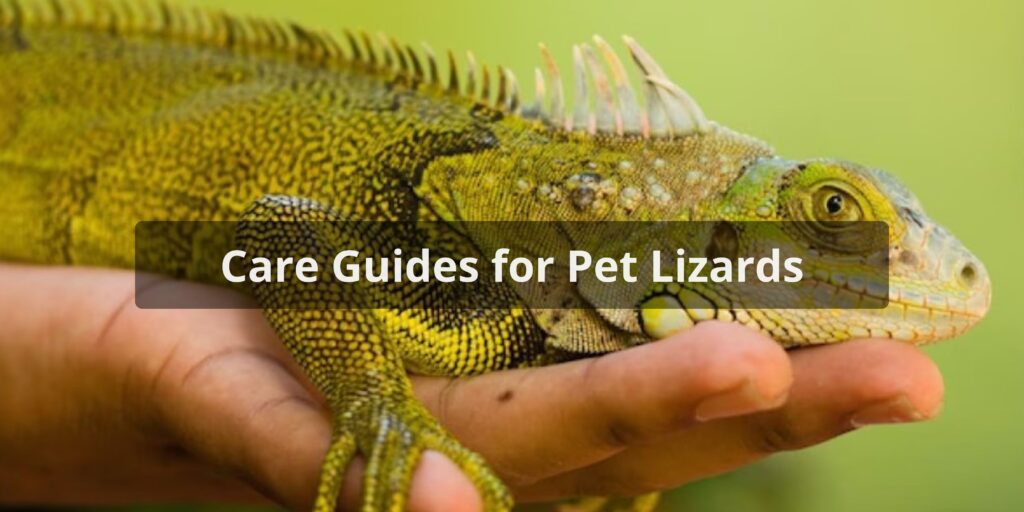Lizards have fascinated humans for centuries due to their diverse shapes, sizes, and colors, making them an attractive option for pet owners seeking something distinctive.
There are numerous species to choose from, such as Bearded Dragons, Geckos, Anoles, Iguanas, and Chameleons, each with their unique qualities and care requirements.
Owning a lizard requires proper care and attention to maintain the animal’s health and happiness. It is essential to conduct research beforehand to select a species that fits your lifestyle and experience level as some lizards are easier to care for than others. Here is a care guides for pet lizards provide all the necessary information you need to know.
About Lizards

Lizards are fascinating creatures that make excellent pets. They are cold-blooded, and many different species of lizards can be kept as pets such as Bearded Dragons, Geckos, Anoles, Iguanas, and Chameleons. Before you consider getting a lizard as a pet, it is essential to have a basic understanding of their behavior, habitat requirements, and health care needs.
Lizard Facts
Lizards are a diverse group of reptiles that belong to the order Squamata, which also includes snakes. With over 6,000 species, lizards can be found in almost every corner of the world, from deserts to rainforests. Here are some interesting facts about lizards:
- Lizards have a wide range of sizes, from the tiny chameleon that can fit on your fingertip to the Komodo dragon, the largest lizard in the world, which can grow up to 10 feet (3 meters) long.
- Some lizards, such as geckos, have specialized toe pads that allow them to climb smooth surfaces like walls and ceilings.
- Many lizards, including iguanas and bearded dragons, have a third eye, called a parietal eye, on the top of their heads. This eye is sensitive to light and helps the lizard detect predators.
- Lizards shed their skin as they grow, just like snakes. Unlike snakes, however, most lizards shed their skin in pieces instead of all at once.
- Many lizards are able to regenerate lost tails. When threatened by a predator, a lizard can detach its tail as a distraction and then regrow a new one later.
- Some lizards, such as the chameleon, can change color to blend in with their surroundings or communicate with other lizards.
- Lizards are cold-blooded, meaning that they rely on external sources of heat to regulate their body temperature. They bask in the sun or move to shady spots to cool down.
- The diet of lizards varies depending on the species. Some, like iguanas, are strictly herbivores, while others, like monitors, are carnivorous and eat insects, small animals, and even other lizards.
- Lizards play an important role in many ecosystems. They are important predators of insects, and some species also help to disperse seeds.
- It’s important to note that not all lizards make good pets. Many require specialized care and diets, and some may even be illegal to own in certain areas. If you’re considering getting a pet lizard, do your research and make sure you can provide the proper care for the species you choose.
Behavior and Temperament
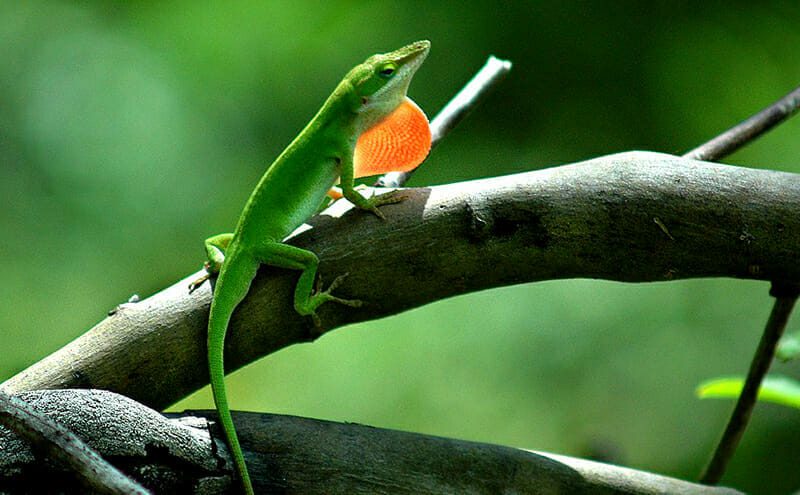
Lizards can be very social animals and enjoy interacting with their owners. However, some lizards may be more aggressive or territorial than others. It’s important to research the specific species of lizard you’re interested in to understand its temperament. Some general trends can be observed.
- Shyness-boldness: Some lizards are naturally shy and skittish, while others are more bold and outgoing. This can be influenced by a number of factors, including the lizard’s upbringing, the type of environment it is kept in, and its individual personality.
- Exploration-avoidance: Some lizards are more curious and exploratory, while others prefer to stay in their enclosures and avoid new things. This can also be influenced by the factors mentioned above.
- Activity: Some lizards are more active and need plenty of space to move around, while others are content to spend most of their time basking or hiding.
- Sociability: Some lizards are more social and enjoy being around other lizards or people, while others prefer to be left alone.
- Conspecific aggression: Some lizards are more aggressive towards other lizards of their own species, while others are more tolerant. This can be influenced by the lizard’s upbringing, the size and sex of the other lizards, and the amount of space available.
When choosing a lizard as a pet, it is important to consider its behavior and temperament. If you are looking for a lizard that is easy to handle and interact with, then a more social and outgoing species may be a good choice. If you are looking for a lizard that is more low-maintenance and independent, then a shyer or more solitary species may be a better fit.
With proper care and attention, most lizards can make great pets. By understanding their behavior and temperament, you can choose a lizard that is right for you and provide it with the best possible home.
Here are some additional tips for understanding and managing the behavior of lizards:
- Observe your lizard’s behavior closely. Pay attention to how it reacts to different things, such as new people or objects, changes in its environment, and handling.
- Be patient and gentle when handling your lizard. Avoid making sudden movements or noises, which can startle it.
- Provide your lizard with plenty of opportunities to explore and hide. This will help to reduce stress and make it feel more comfortable.
- If your lizard is displaying aggressive behavior, try to identify the cause. Is it being stressed? Is it being handled too much? Once you have identified the cause, you can take steps to address it.
With a little understanding and patience, you can learn to manage the behavior of your lizard and create a happy and healthy home for it.
Habitat Requirements
It’s important to provide your lizard with a suitable living environment for their well-being and contentment. Here are a few things to think about.
Lizards Lighting, Temperature Humidity Needs
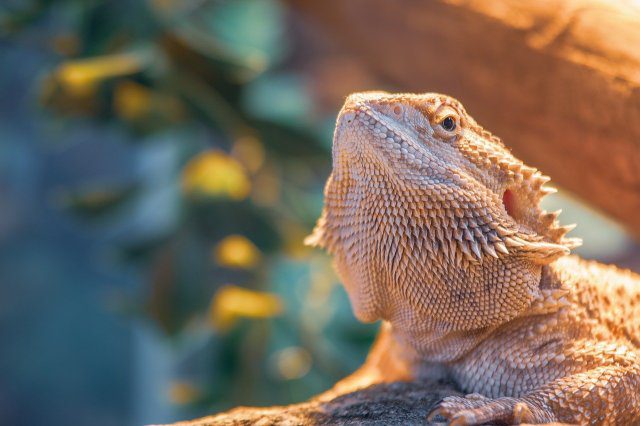
Lighting: All lizards need a source of UVB light. UVB light helps them produce vitamin D3, which is essential for bone health. The best type of UVB light for lizards is a fluorescent bulb that emits UVA and UVB rays. The bulb should be placed over the basking area so that the lizard can bask directly under it. The bulb should be replaced every 6-12 months, or sooner if it starts to lose its output.
Temperature: The temperature of the lizard’s enclosure should be maintained in a gradient, with a warm side and a cool side. The warm side should be around 85-100 degrees Fahrenheit (30-38 degrees Celsius), and the cool side should be around 75-85 degrees Fahrenheit (24-30 degrees Celsius). The temperature can be regulated with a heat lamp or heat mat.
Humidity: The humidity level in the lizard’s enclosure will also vary depending on the species. Some lizards, such as desert lizards, prefer dry conditions, while others, such as rainforest lizards, prefer humid conditions. The humidity level should be monitored and adjusted as needed.
Substrate (Bedding) Options
Choosing the right substrate is essential for your lizard’s health and hygiene. There are many options available, including newspaper, cypress mulch, coconut fiber, and sand. Each material has its benefits and drawbacks, so it’s important to research the needs of your specific lizard to choose the best substrate.
- Newspaper: This is a cheap and easy-to-clean substrate that is also non-toxic. However, it is not very aesthetically pleasing and can be difficult to keep clean if your lizard is a messy eater. [Image of Newspaper as lizard substrate]
- Cypress mulch: This is a natural substrate that is soft and absorbent. It is also relatively inexpensive and easy to find. However, it can be dusty and may mold if it is not kept dry. [Image of Cypress mulch as lizard substrate]
- Coconut fiber: This is another natural substrate that is soft and absorbent. It is also non-toxic and mold-resistant. However, it can be more expensive than other substrates and may not be suitable for all lizards. [Image of Coconut fiber as lizard substrate]
- Sand: This is a natural substrate that is often used for desert lizards. However, it can be dangerous if your lizard ingests it, as it can cause impaction. [Image of Sand as lizard substrate]
- Reptile carpet: This is a synthetic substrate that is easy to clean and non-toxic. However, it can be slippery and may not provide enough traction for some lizards. [Image of Reptile carpet as lizard substrate]
The best substrate for your lizard will depend on its species, age, and activity level. It is important to do your research and choose a substrate that is safe, comfortable, and easy to maintain.
Here are some additional factors to consider when choosing a substrate:
- The size of your lizard: Smaller lizards may need a substrate that is easier to burrow in, such as sand or cypress mulch. Larger lizards may need a substrate that is more absorbent, such as coconut fiber.
- The climate of your home: If you live in a humid climate, you will need to choose a substrate that is mold-resistant. If you live in a dry climate, you will need to choose a substrate that is absorbent.
- The activity level of your lizard: If your lizard is very active, you will need to choose a substrate that is easy to clean and maintain. If your lizard is less active, you may be able to get away with using a substrate that is more difficult to clean.
Ultimately, the best way to choose the right substrate for your lizard is to consult with a veterinarian or reptile expert. They can help you select a substrate that is safe, healthy, and comfortable for your specific lizard.
Cages
The size of the cage needed for your lizard depends on its species and size. This is because different species of lizards have different needs in terms of space, temperature, and humidity. For example, a small lizard like a gecko may only need a 20-gallon tank, while a larger lizard like a bearded dragon may need a 120-gallon tank.
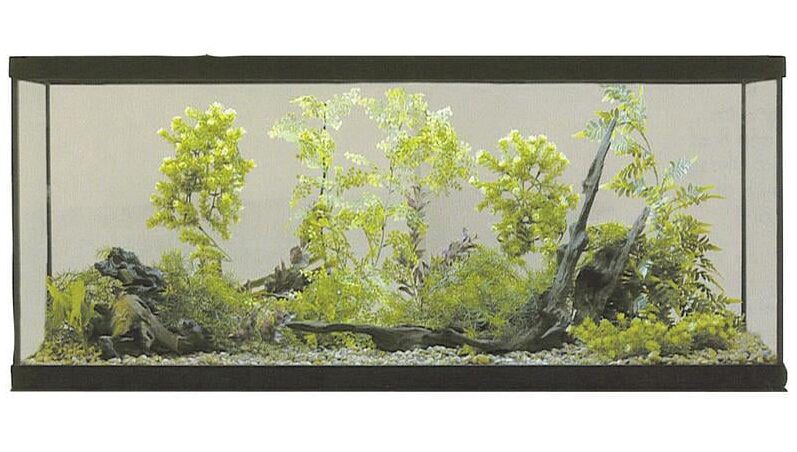
In general, a larger enclosure is better for lizards, as it allows them more room to climb, hide, and explore. This can help to reduce stress and promote good health. When choosing a cage, it is important to consider the following factors:
- The size of the lizard: The cage should be at least twice the length of the lizard.
- The species of the lizard: Some lizards are more arboreal (tree-dwelling) than others, so you will need to choose a cage that is tall enough for them to climb.
- The temperature and humidity requirements of the lizard: The cage should be able to maintain the proper temperature and humidity levels for the lizard’s species.
- The amount of space needed for enrichment: The cage should have enough space for the lizard to have hiding places, basking spots, and other enrichment items.
Here are some additional tips for choosing a cage for your lizard:
- Choose a cage that is made of a durable material that can withstand the lizard’s claws and teeth.
- Make sure the cage has a secure lid to prevent the lizard from escaping.
- The cage should have good ventilation to prevent the buildup of heat and humidity.
- Line the bottom of the cage with a substrate that is safe for the lizard, such as sand, bark, or paper towels.
- Add plants, rocks, and other decorations to the cage to provide the lizard with hiding places and enrichment.
Decorating Your Lizard’s Enclosure
Decorating your lizard’s enclosure is not just a fun activity, but it also helps to create a comfortable and stimulating environment for your pet. Here are some tips on how to decorate your lizard’s enclosure:
- Add hiding spots: Lizards need a place to retreat and hide when they feel stressed or threatened. You can use rocks, logs, or plants to create hiding spots in the enclosure. Make sure the hiding spot is big enough for your lizard to fit inside comfortably.
- Provide climbing opportunities: Lizards are natural climbers, so providing climbing opportunities in their enclosure will give them exercise and stimulation. You can add branches, vines, or rocks to create climbing structures.
- Use artificial plants: Artificial plants are a great way to add color and texture to your lizard’s enclosure without worrying about any harmful chemicals or toxins that may exist in real plants. They also require less maintenance than live plants.
- Include a basking area: Most lizards require a basking area where they can soak up heat and UVB rays from a heat lamp. You can use rocks or logs to create a raised platform where your lizard can bask.
- Don’t overcrowd the enclosure: While it’s important to provide enrichment and stimulation, you should avoid overcrowding the enclosure. Overcrowding can lead to stress and aggression among lizards. The general rule of thumb is to provide at least one square foot of floor space per inch of the lizard’s total length.
Cleaning Sanitation Regimen
Keeping your lizard’s enclosure clean is essential for its health and well-being. A dirty enclosure can harbor bacteria and parasites that can make your lizard sick. It can also be a breeding ground for mold and mildew, which can irritate your lizard’s skin and respiratory system.
Here are some tips for keeping your lizard’s enclosure clean:
- Do a daily spot clean. This means removing any uneaten food, feces, or shed skin. You can use a paper towel or a reptile-safe disinfectant wipe to clean up these messes.
- Do a weekly deep clean. This involves removing all of the substrate, cleaning the walls and decorations, and replacing the substrate. You can use a mild bleach solution (1 part bleach to 10 parts water) to disinfect the enclosure, but be sure to rinse it thoroughly afterwards.
- Change the water daily. This is especially important for aquatic reptiles.
- Inspect the enclosure regularly for any signs of mold or mildew. If you see any, clean it immediately.
Here are a few extra points to consider that can aid in guaranteeing its well-being and contentment over the long run.
- Use a substrate that is easy to clean, such as paper towels, newspaper, or reptile carpet.
- Avoid using sand or gravel as a substrate, as these can harbor bacteria and parasites.
- Provide your lizard with plenty of hiding places to help keep it clean.
- Dispose of waste and uneaten food properly.
- The specific cleaning schedule you need to follow will vary depending on the type of lizard you have and the size of its enclosure.
- If your lizard is sick, you may need to clean its enclosure more often.
- Be sure to wear gloves and a mask when cleaning the enclosure to avoid contact with bacteria or parasites.
Health Care for Lizards
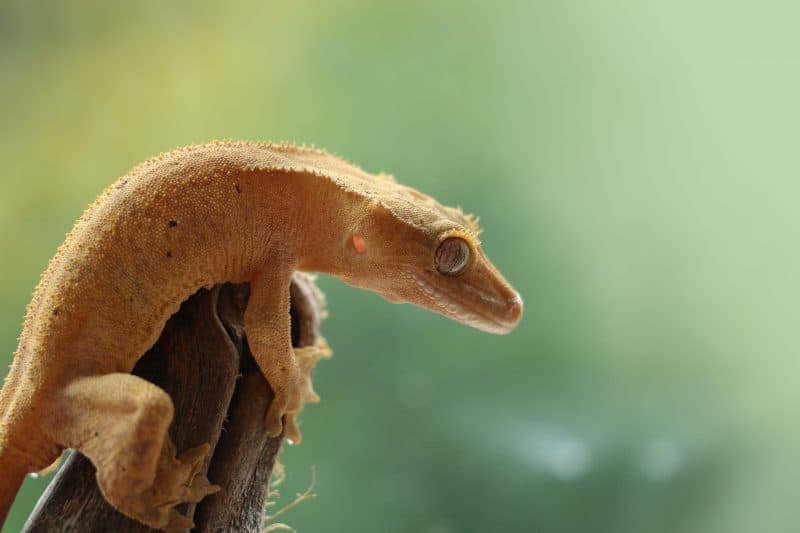
Maintaining your lizard’s health requires both preventative measures and prompt treatment when necessary. Here are some things to keep in mind:
First-Aid Preparation for Lizards
Having a first-aid kit and knowledge of how to provide basic first aid for lizards can help you quickly respond to emergencies and accidents. A basic first-aid kit for lizards should include:
- Disinfectant, such as betadine or chlorhexidine
- Gauze pads
- Bandages
- Tweezers
- Scissors
- Q-tips
- Styptic powder (to stop minor bleeding)
- Topical antibiotic cream
- Heat pack or hot water bottle (for keeping your pet warm during transport)
- Emergency contact information for your veterinarian
Remember to always handle your lizard gently and carefully, and never attempt any first-aid procedures that you are not comfortable with. In case of serious injury or illness, always seek the advice of a qualified reptile veterinarian.
Lizards Common Diseases, Illnesses
Lizards are fascinating reptiles that make great pets, but like any animal, they can get sick and require medical attention. There are several common diseases and illnesses that affect lizards, ranging from minor conditions to more serious health issues.
- Metabolic Bone Disease (MBD) is the most common disease in captive lizards. It is caused by a lack of calcium and vitamin D3 in the diet. Symptoms of MBD include lethargy, soft bones, and difficulty walking.
- Respiratory infections are also common in lizards. They can be caused by bacteria, viruses, or parasites. Symptoms of respiratory infections include open-mouth breathing, discharge from the nose, and difficulty breathing.
- Scale rot is a skin infection that can be caused by bacteria or fungi. It is often seen in lizards that are kept in damp or unsanitary conditions. Symptoms of scale rot include redness, swelling, and discharge from the skin.
- Mouth rot is a bacterial infection that can affect the mouth, tongue, and gums of lizards. It is often seen in lizards that are not getting enough vitamin A. Symptoms of mouth rot include red, swollen gums, and difficulty eating.
- Parasites are another common cause of disease in lizards. They can be internal parasites, such as worms, or external parasites, such as mites or ticks. Symptoms of parasites can vary depending on the type of parasite.
- Eye problems are also relatively common in lizards. They can be caused by a variety of factors, including injuries, infections, and parasites. Symptoms of eye problems include redness, swelling, discharge, and difficulty seeing.
It is important to take your lizard to the vet if you notice any signs of illness. Early diagnosis and treatment is essential for a good prognosis.
Giving Medication to Lizards
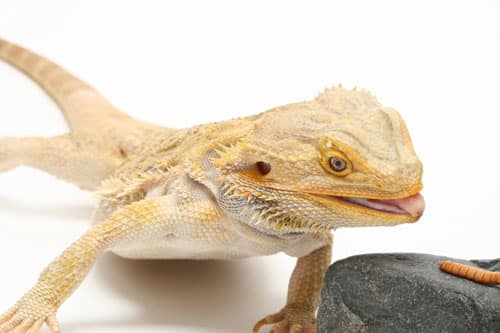
Lizards are a unique type of reptile and have specific requirements when it comes to their health and wellbeing. Administering medication to lizards can be a challenging task, as it requires a delicate balance of precision and patience.
- Lizards are often skittish and can be difficult to handle. This can make it difficult to get them to open their mouths for oral medications or to stay still for injections.
- Lizards have a different metabolism than mammals, so the dosage of medication that is safe for a mammal may be too high or too low for a lizard. It is important to follow your veterinarian’s instructions carefully to ensure that your lizard is getting the correct dosage.
- Some medications can be harmful to lizards if they are not administered properly. For example, oral medications that are not swallowed can enter the respiratory tract and cause aspiration pneumonia. Injections that are given in the wrong location can cause pain, infection, or even death.
Here are some tips for administering medication to lizards:
- Have a helper restrain the lizard. This will make it easier to give the medication and will help to prevent the lizard from biting you.
- Be gentle and patient. Lizards can be easily stressed, so it is important to be gentle and patient when giving them medication.
- Use the correct dosage. Always follow your veterinarian’s instructions for the dosage of medication.
- Administer the medication in the correct location. If you are giving an injection, be sure to inject the medication in the correct location.
- Monitor your lizard closely after giving the medication. Watch for any signs of adverse reactions, such as vomiting, diarrhea, or lethargy.
If you have any questions or concerns about administering medication to your lizard, be sure to talk to your veterinarian. They can help you choose the right medication and give you instructions on how to administer it safely and effectively.
Nutritious Diet for Lizards
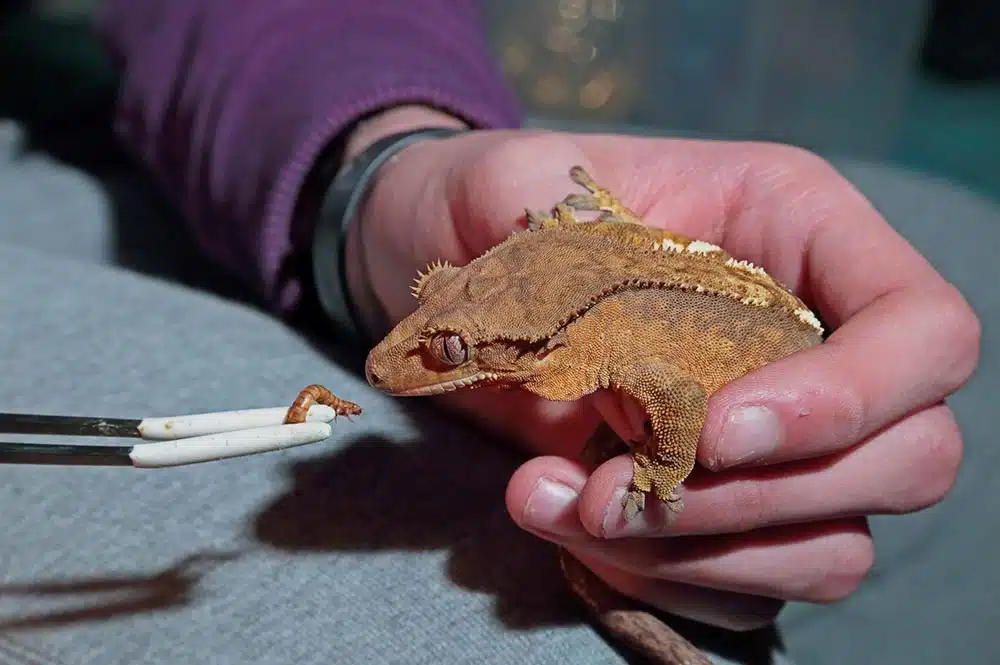
Feeding your lizard a balanced diet is essential for its overall health and well-being. Here are some things to consider:
Insects Plant Ratio
Sure, here is an explanation:
The dietary needs of lizards vary depending on the species. Some lizards are insectivores, meaning they eat insects and other invertebrates. Others are omnivores, meaning they eat both plants and animals. And still others are herbivores, meaning they only eat plants. Here are some general guidelines for feeding lizards:
- Insectivores should be fed a variety of insects, such as crickets, mealworms, and waxworms. The insects should be gut-loaded with a diet of vegetables and fruits to provide the lizard with essential nutrients.
- Omnivores can be fed a diet of insects, fruits, vegetables, and leafy greens. The proportions of each food item will vary depending on the species of lizard.
- Herbivores should be fed a diet of leafy greens, fruits, and vegetables. Some herbivorous lizards may also need to be supplemented with calcium and other vitamins.
Additional recommendations can help ensure that your pet lizard is getting the right nutrition it needs to be healthy and happy.
- Avoid feeding your lizard wild-caught insects, as they may contain parasites or pesticides.
- Dust the insects you feed your lizard with a calcium supplement to prevent deficiencies.
- Offer your lizard a variety of food items to ensure it is getting all the nutrients it needs.
- Do not overfeed your lizard, as this can lead to obesity and other health problems.
Feeding Supplements
Supplements can be an essential tool for ensuring that your pet lizard is receiving all the necessary vitamins and minerals it needs to maintain optimal health. Lizards, like many other reptiles, have specific requirements for nutrition which can be challenging to meet via their diet alone. This is where supplements come in handy.
- Calcium is essential for strong bones and a healthy immune system. Most lizards do not get enough calcium from their diet, so it is important to supplement their food with calcium powder.
- Vitamin D3 helps the body absorb calcium. It is also important for good vision and a healthy immune system. Indoor lizards do not get enough sunlight, which is necessary for the body to produce vitamin D3. Therefore, it is important to supplement their diet with vitamin D3.
- Multivitamins can help ensure that your lizard is getting all the other vitamins and minerals it needs. Some common vitamins and minerals that are important for lizards include vitamin A, vitamin C, and vitamin E.
It’s important to note that while supplements can be helpful, they should never replace a proper diet. Ideally, you should aim to feed your lizard a varied and balanced diet that meets its nutritional needs. Supplements should be used only to fill any gaps in their diet and should be administered according to the manufacturer’s instructions.
Water
Lizards are ectotherms, which means they rely on external sources of heat to regulate their body temperature. They also have a relatively low metabolic rate, which means they don’t need to drink as much water as mammals or birds. However, they still need access to clean water at all times, especially in hot weather.
The amount of water a lizard needs will vary depending on the species, the climate, and the activity level of the lizard. Some lizards, such as desert-dwelling lizards, can get most of their water from their food. However, most lizards need to drink water regularly.
The best way to provide water for a lizard will depend on the species of lizard. Some lizards, such as leopard geckos, will drink from a shallow dish. Others, such as chameleons, may prefer to drink from a drip system. It is important to make sure that the water is fresh and clean, and that the water dish or drip system is large enough for the lizard to drink comfortably.
Here are some tips for providing water for lizards:
- Use a shallow dish or drip system that is large enough for the lizard to drink comfortably.
- Change the water daily, or more often if the water becomes dirty or contaminated.
- Clean the water dish or drip system regularly with a mild soap and water solution.
- Avoid using water that contains chlorine or chloramine, as these chemicals can be harmful to lizards.
Keeping Lizards in Winter

During the colder months, your lizard may require additional heating or lighting to maintain its health.It’s essential to monitor the temperature and humidity levels in their enclosure regularly. You may also need to adjust their diet and activity levels as some species may become less active during the winter months.
Keeping lizards in winter can be a challenge, as they are cold-blooded animals and need to maintain a certain body temperature to stay healthy. Here are some tips on how to keep your lizard warm and healthy during the winter months:
- Provide a heat source. The most important thing you can do to keep your lizard warm is to provide a heat source in its enclosure. This could be a heat lamp, a heat mat, or a combination of both. The temperature in the basking area should be around 85-95 degrees Fahrenheit.
- Use a thermostat. A thermostat is essential to ensure that the heat source is not too hot. It should be set to keep the temperature in the basking area within the desired range.
- Insulate the enclosure. This will help to keep the heat in and the cold out. You can use bubble wrap, foam, or other insulating materials.
- Keep the enclosure clean and dry. Cold, wet conditions can make your lizard more susceptible to illness. Make sure to clean the enclosure regularly and provide fresh water daily.
- Offer a humid hide. Some lizards, such as bearded dragons, need a humid hide to help them shed their skin. This can be a small container filled with damp moss or paper towels.
- Reduce feeding during winter. Lizards do not need as much food in the winter as they do in the summer. You can reduce the amount of food you give them by about 25%.
- Be patient. Lizards may become less active in the winter. This is normal and nothing to worry about. Just make sure they are still eating and drinking regularly.
How to Handle Your Lizard
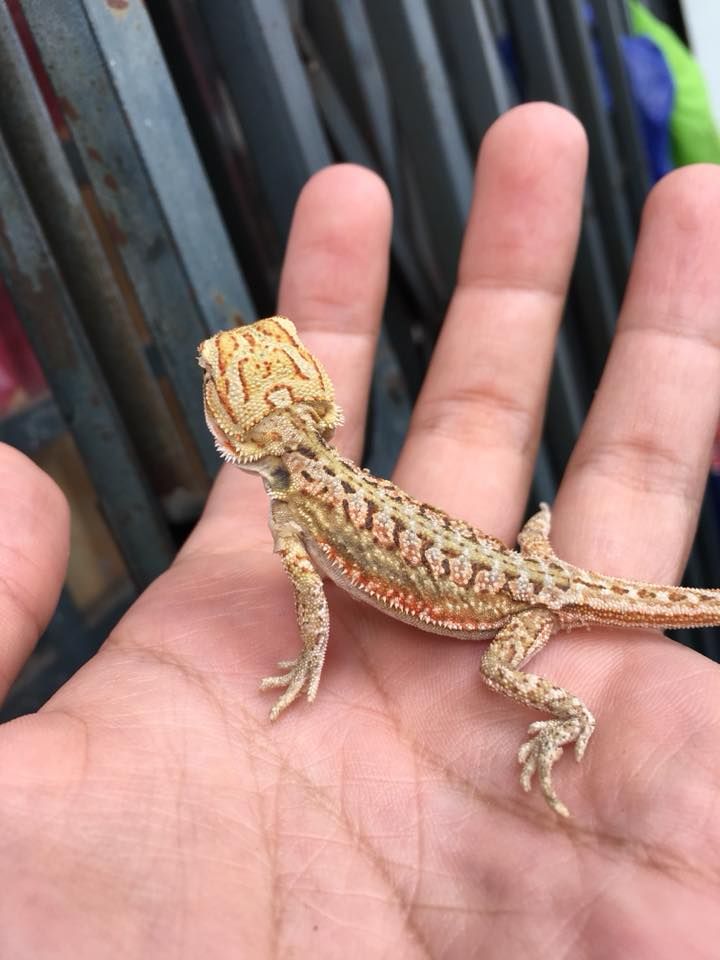
Handling your lizard can be a rewarding experience for both you and your pet. Lizards thrive on social interaction and handling, but it’s important to approach this activity with caution and care to avoid causing stress or injury to your reptilian friend.
- Start slowly. Don’t try to handle your lizard right away. Let it get used to your presence first. Spend time sitting near its cage and talking to it in a soft voice.
- Use two hands. When you do start handling your lizard, use two hands to support it. This will help to prevent it from feeling unbalanced or scared.
- Support its body. When you hold your lizard, support its body with your hands. Don’t just grab it by the tail or the limbs. This can hurt it or even cause it to lose its tail.
- Be gentle. When handling your lizard, be gentle and avoid sudden movements. This will help to keep it calm and relaxed.
- Don’t handle your lizard for too long. Lizards can get stressed out if they are handled for too long. Start with short handling sessions and gradually increase the length of time as your lizard gets used to it.
- End the handling session on a positive note. When you are finished handling your lizard, put it back in its cage and give it a treat. This will help it to associate handling with positive experiences.
With a little patience and care, you can learn to handle your lizard safely and comfortably. This will help you to build a strong bond with your pet and enjoy many years of companionship together. Here are some additional things to keep in mind when handling your lizard:
- Wash your hands thoroughly with soap and water before and after handling the lizard.
- Avoid handling your lizard during feeding time or after it has just woken up. These are times when it is more likely to be stressed or defensive.
- If your lizard starts to get scared or stressed, put it back in its cage immediately. Don’t force it to stay out.
Difficulty when Caring for Lizards
Caring for lizards can be challenging when Caring for Lizards as they require specific conditions to thrive. It’s important to research the needs of your specific species before bringing one home. Here are some things you should not do with a lizard:
- Handle it too much or too little. Too much handling can stress out a lizard and make it lose its tail. Too little handling can make it become aggressive or fearful.
- Hold it by the tail or legs. This can hurt the lizard and make it drop its tail.
- Hold it above your head or in high places. Some lizards are jumpers and can easily escape from your grasp.
- Force it to eat or drink. Lizards will eat and drink when they are hungry or thirsty. Forcing them to do so can make them sick.
- Put it in a cage that is too small or too hot or cold. Lizards need a proper environment to stay healthy. Make sure the cage is the right size and that the temperature and humidity are within the correct range.
- Expose it to harsh chemicals or cleaning products. These can irritate the lizard’s skin or eyes.
- Take it outside without proper protection. Lizards can carry diseases that can be harmful to humans. If you take it outside, make sure to wear gloves and a mask.
If you find a lizard in your home, the best thing to do is to leave it alone. If it is a nuisance, you can try to catch it and release it outside. However, be careful not to injure it in the process.
These are some of the lizards that require the most challenging care.
- Chameleons: Chameleons are very delicate and require very specific care conditions. They need a high humidity level, a temperature gradient, and special UVB lighting. They are also very skittish and can be difficult to handle.
- Chinese water dragons: Chinese water dragons are large lizards that need a large enclosure. They also need a water feature, such as a pool or waterfall. They are not as delicate as chameleons, but they still require specialized care.
- Tokay geckos: Tokay geckos are known for their loud, barking call. They are also very territorial and can be aggressive towards other lizards or people. They require a warm, humid environment and a diet of insects.
- Iguanas: Iguanas are large lizards that can grow up to 6 feet long. They need a very large enclosure and a high humidity level. They are also very active and need plenty of space to roam.
- Caimans or alligators: Caimans and alligators are large, aquatic reptiles that require a very large enclosure. They are also very aggressive and should only be kept by experienced reptile keepers.
If you are a beginner, it is best to choose a lizard species that is known for being easy to care for. Some good options for beginners include leopard geckos, bearded dragons, and crested geckos. These lizards are relatively hardy and can adapt to a variety of living conditions.
No matter what species of lizard you choose, it is important to do your research and learn about their specific care requirements. With proper care, your lizard can live a long and healthy life.
Conclusion
Overall, lizards can make wonderful pets for those who are willing to invest the time, effort, and resources into properly caring for them. Before bringing home a new lizard, be sure to educate yourself on their behavior, habitat requirements, and health care needs to ensure a long and happy life for your scaly friend.
Understanding their behavior, habitat requirements, health care needs, and nutritional requirements is essential for providing a happy and healthy life for your pet lizard. By following Care Guides for Pet Lizards, you can create an ideal environment for your pet lizard and enjoy many years of companionship with them.
FAQs About Care Guides for Pet Lizards
What specific heating equipment is recommended for my pet lizard’s winter habitat?
To ensure proper winter temperatures, consider using heat lamps, ceramic heat emitters, or under-tank heat mats. These options offer controlled warmth without emitting light during the night, which supports your lizard’s natural day-night cycle.
Are there certain lizard species that are better suited for colder temperatures?
Yes, some lizard species, such as bearded dragons and leopard geckos, tolerate cooler temperatures better than others. However, it’s essential to research the specific requirements of your lizard’s species and provide adequate heating to maintain their health and well-being.
How do I create a proper winter lighting schedule for my lizard’s enclosure?
Adjust the lighting to mimic natural winter daylight hours. Provide 10-12 hours of light and 12-14 hours of darkness to maintain your lizard’s natural circadian rhythm. Utilize timers to ensure consistent light cycles, which helps regulate their behavior and metabolism.
Can I use space heaters to regulate the temperature in the room where the lizard’s enclosure is kept?
While space heaters can help maintain room temperature, they might not provide precise control within the enclosure. It’s safer and more effective to use specialized heating equipment directly in the enclosure, such as heat lamps or heat mats, to ensure your lizard’s thermal needs are met.
What are some common mistakes to avoid when caring for pet lizards during the winter?
Avoid placing the enclosure near drafty areas, sudden temperature fluctuations, or exposing your lizard to cold temperatures. Overheating or underheating the habitat can stress or harm your pet. Always monitor temperature, humidity, and lighting to prevent these mistakes.
Are there any supplements I should provide to my lizard during the winter months?
Depending on your lizard’s diet and species, consider providing calcium and vitamin supplements. Winter might limit their access to natural sunlight, impacting their ability to synthesize these essential nutrients. Consult a veterinarian for proper supplement recommendations.
How do I ensure my lizard stays hydrated in the drier indoor air of winter?
Place a shallow water dish within the enclosure to help maintain humidity levels and provide a water source for drinking. Regularly mist the enclosure to increase humidity, and monitor the humidity levels using a hygrometer to prevent dehydration.
What are the signs of temperature-related stress?
Signs of temperature-related stress in lizards include lethargy, loss of appetite, difficulty moving, changes in coloration, and seeking excessively warm or cool spots. Monitor your lizard’s behavior and adjust the enclosure’s temperature to alleviate stress and maintain their well-being.

